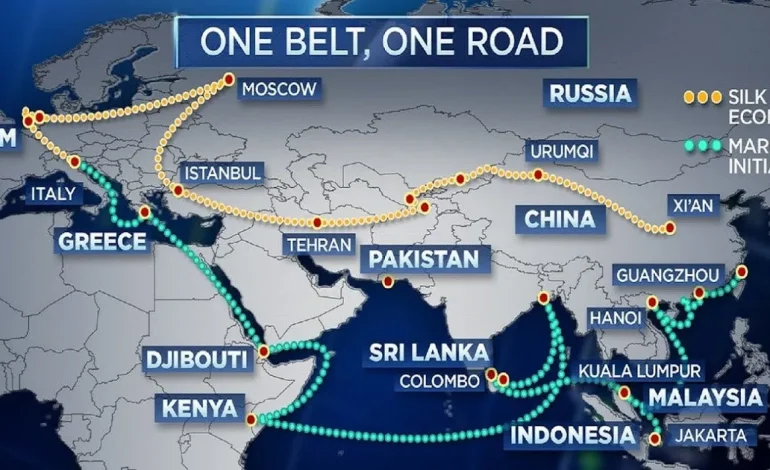BRI Tech 3.0: China’s Digital Belt Expands Beyond Infrastructure

Introduction
China’s Belt and Road Initiative (BRI) is entering a new phase known as BRI Tech 3.0, emphasizing digital infrastructure, AI integration, and smart city technologies. Moving beyond traditional transport and energy projects, the initiative now prioritizes connectivity through cloud computing, fintech corridors, and intelligent logistics networks. This expansion strengthens China’s regional influence while fostering technology adoption and economic development across participating countries.
Strategic Direction
BRI Tech 3.0 aims to create a digital belt linking Asia, Europe, and Africa through smart infrastructure, data centers, and fintech platforms. China’s Ministry of Industry and Information Technology emphasizes cross-border data exchange, cybersecurity, and AI-driven solutions for trade, transportation, and energy management. The initiative also promotes regional standards for cloud computing, IoT, and digital payment systems, enhancing interoperability and economic integration.

Key Objectives
- Deploy cloud infrastructure and data centers along BRI corridors.
- Integrate AI solutions in smart ports, logistics hubs, and manufacturing zones.
- Establish fintech corridors for cross-border trade, payment systems, and programmable finance applications.
Policy Support
National-level guidance ensures alignment with China’s digital economy strategy. Local governments in participating regions receive technical assistance, training programs, and investment incentives to adopt AI and cloud solutions. Collaborative frameworks with domestic tech firms, including Alibaba Cloud, Tencent AI Labs, and Huawei, facilitate implementation.
Technology Integration
BRI Tech 3.0 leverages advanced technology to optimize trade and infrastructure efficiency. Smart ports employ AI for predictive cargo handling, automated customs clearance, and optimized shipping routes. Cloud-based systems enable real-time monitoring of supply chains, energy networks, and urban services. Blockchain and modular digital finance frameworks are being piloted to improve transparency, traceability, and cross-border settlement efficiency.
Industry Applications
- Logistics: AI algorithms optimize cargo loading, route planning, and warehouse management.
- Energy: Smart grids use predictive analytics for renewable energy allocation and consumption monitoring.
- Finance: Fintech corridors enable secure cross-border payments and programmable finance for infrastructure projects.
Role of Domestic Firms
Chinese tech giants provide the backbone for BRI Tech 3.0. Alibaba Cloud supports cloud infrastructure and AI analytics, Tencent AI Labs offers machine learning solutions for logistics and financial services, and Huawei supplies telecommunications hardware for 5G-enabled connectivity. Local startups contribute innovation in IoT devices, smart sensors, and blockchain platforms.
Economic and Market Implications
The digital BRI enhances trade efficiency, reduces transaction costs, and strengthens regional economic resilience. Countries participating in BRI Tech 3.0 benefit from technology transfer, improved infrastructure management, and enhanced connectivity with China’s domestic market. Investment in AI-driven logistics and cloud infrastructure accelerates industrial upgrades, creating new growth opportunities for local firms.
Trade and Investment Flow
BRI countries have reported increased trade volume facilitated by AI-enabled customs and logistics optimization. Investment in smart ports and data centers has attracted regional and international partners, promoting economic diversification and industrial modernization.
Market Growth Indicators
- Smart port projects in Southeast Asia have reduced cargo dwell times by 15–20 percent.
- Regional fintech corridors have increased cross-border transaction volume by 25 percent year-on-year.
- AI-driven industrial parks report productivity gains of 10–12 percent.
Challenges and Risks
Implementing BRI Tech 3.0 faces several challenges. Cybersecurity threats, regulatory differences, and talent shortages are key concerns. Ensuring interoperability of AI, cloud, and fintech systems across multiple countries requires standardized protocols and international collaboration. Additionally, reliance on Chinese technology raises geopolitical sensitivities in certain regions, potentially affecting adoption rates.
Talent Development
Programs to train local engineers, data scientists, and AI specialists are underway to address workforce gaps. Knowledge transfer through joint ventures, workshops, and online courses ensures long-term sustainability of digital infrastructure projects.
Regulatory Compliance
Cross-border data policies, cybersecurity regulations, and financial supervision vary across countries. BRI Tech 3.0 projects adopt risk mitigation strategies, including encryption, blockchain verification, and modular compliance frameworks to balance innovation with regulatory adherence.
Alignment with Digital Finance and Innovation
BRI Tech 3.0 aligns with emerging digital finance models, including programmable money systems and modular investment frameworks. These tools enable automated, transparent financing for infrastructure projects, improving efficiency and accountability. They also facilitate integration with AI-driven governance systems, ensuring that digital and financial infrastructures work synergistically to support regional development.
Pilot Programs
- Programmable finance trials for cross-border infrastructure payments.
- AI-assisted financial monitoring to reduce fraud and optimize project funding.
- Blockchain-enabled tracking of goods and transactions along logistics corridors.
Long-Term Benefits
The combination of AI, cloud computing, and programmable finance under BRI Tech 3.0 strengthens regional economic resilience, enhances China’s technological influence, and promotes sustainable industrial and urban development.
Outlook 2030
By 2030, BRI Tech 3.0 is expected to establish a fully integrated digital belt connecting Asia, Europe, and Africa. AI-enabled logistics, smart ports, and fintech corridors will streamline trade and investment flows. Regional industrial zones will adopt cloud-based analytics for productivity, and programmable finance models will support cross-border infrastructure funding. The initiative positions China as a leader in regional digital infrastructure while contributing to sustainable economic growth across participating countries.
Conclusion
BRI Tech 3.0 represents a transformative evolution of the Belt and Road Initiative, shifting focus from traditional infrastructure to digital connectivity, AI integration, and smart finance. By leveraging advanced technology and collaboration with domestic tech firms, China enhances regional competitiveness, fosters economic modernization, and strengthens strategic influence across participating countries. The initiative demonstrates how innovation, digital infrastructure, and programmable finance can converge to create resilient and interconnected economic ecosystems in Asia and beyond.






